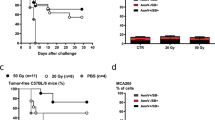Abstract
Since the beneficial effects of low-dose radiation (0.01 Gy) are usually observed in normal cells, we investigated whether the adaptive response was induced by low-dose radiation in neoplastic cells of different origin as well as in normal cells. Cell lines used in this experiment were as follows: mouse lymphocytes (NL); L929 cells established from mouse connective tissue; primary mouse keratinocytes (PK); line 308 from mouse papilloma; X-ray sensitive lymphoma cells, L5178Y-S and EL-4 cells from mouse lymphoma. The adaptive response was determined by cell survival and apoptosis. The involvement of apoptosis in the adaptive response was examined by ELISA and TUNEL assay. Adaptive response was induced by pretreatment with low-dose radiation of 0.01 Gy in normal cells such as NL, L929, and PK, but not in L5178Y-S, EL-4, and line 308 cells. In addition, the reduction of apoptosis by pretreatment with low-dose radiation was observed in NL, L929, and PK, but not in L5178Y-S, EL-4, and line 308 cells. These results suggested that the adaptive response could be induced by pretreatment with low-dose radiation and the phenomena were observed in normal cells, not in neoplastic cells. In addition, pretreatment with low-dose radiation reduced apoptosis, suggesting that an anti-apoptotic pathway may be involved in the adaptive response.
Similar content being viewed by others
References
Abend M, Rhein A, Gilbertz KP, Blakely WF, van Beuingen D. Correlation of micronucleus and apoptosis assays with reproductive cell death. Int J Radiat Biol. 1995;3:315–26.
Afanas'ev VN, Korl' BA, Mantsygin YA, Nelipovich PA, Pechatnikov VA, Umaksky SR. Flow cytometry and biochemical analysis of DNA degradation characteristic of two types of cell death. FEBS Lett. 1986;194:347–50.
Azzam EI, Raaphors GP, Mitchel REJ. Radiation induced adaptive response for protection against micronucleus formation and neoplastic transformation in C3H 10T/1/2 mouse embryo cells. Radiat Res. 1994;138:S28–31.
Bosi A, Olivieri G. Variability of the adaptive response to ionizing radiation in humans. Mutat Res. 1989;211:13–7.
Boothman DA, Meyers M, Odegaard E, Wang M. Altered G1 checkpoint control determines adaptive survival responses to ionizing radiation. Mutat Res. 1996;358:143–53.
Cai L, Liu SZ. Induction of cytogenetic adaptive response of somatic and germ cells in vivo and in vitro by low-dose X-irradiation. Int J Radiat Biol. 1985;58:187–94.
Fan S, Vijayalaxmi G, Mindek G, Burkart W. Adaptive response to 2 low doses of X-rays in human blood lymphocytes. Mutat Res. 1990;243:53–6.
Farooqi Z, Kesavan PC. Low dose radiation-induced adaptive response in bone marrow cells of mice. Mutat Res. 1993;302:83–9.
Hennings H, Michael D, Cheng C, Steinert P, Holbrook K, Yuspa SH. Calcium regulation of growth and differentiation of mouse epidermal cells in culture. Cell. 1980;19:245–54.
Hyun SJ, Yoon MY, Kim TH, Kim JH. Enhancement of mitogen-stimulated proliferation of low dose radiation-adapted mouse splenocytes. Anticancer Res. 1997;17:225–30.
Ishii K, Watanabe M. Participation of gap-junctional cell communication on the adaptive response in human cells induced by low dose of X-rays. Int J Radiat Biol. 1996;69:291–9.
Ljungman M. The influence of chromatin structure on the frequency of radiation-induced DNA breaks: a study using nuclear and nucleoid monolayers. Radiat Res. 1991;128:58–64.
Noma A, Tsuboi N. Dependence of junctional conductance on proton, calcium and magnesium ions in cardiac paired cells of guinea-pig. J Physiol. 1997;382:193–211.
Olivieri G, Bodycote J, Wolff S. Adaptive response of human lymphocytes to low concentrations of radioactive thymidine. Science. 1984;223:594–7.
Radford IR. Mouse lymphoma cells that undergo interphase death show markedly increased sensitivity to radiation-induced DNA double strand breakage as compared with cells that undergo mitotic death. Int J Radiat Biol. 1991;59:1353–69.
Samson L, Schwartz JL. Evidence for an adaptive DNA repair pathway in CHO and human skin fibroblast cell lines. Nature. 1980;287:861–3.
Seong JS, Suh CO, Kim GE. Adaptive response to ionizing radiation induced by low doses of gamma rays in human cell lines. Int J Radiat Oncol Biol Phys. 1995;33:869–74.
Shadley JD, Wolff S. Very low doses of X-ray can cause human lymphocytes to become less susceptible to ionizing radiation. Radiat Res. 1987;111:511–17.
Stephens LC, Ang KK, Schultheiss TE, Milas L, Meyn RE. Apoptosis in irradiated murine tumors. Radiat Res. 1989;120:140–53.
Strickland JE, Greenhalgh DA, Koceva-Chyla A et al. Development of murine epidermal cell lines which contain an activated rasHa oncogene and form papillomas in skin grafts on athymic nude mouse hosts. Cancer Res. 1988;48:165–9.
Szekely JG, Lobreau AU. High radiosensitivity of MOLT-4 leukaemic cell line. Int J Radiat Biol. 1985;48:277–84.
Trosko JE. Possible role of intercellular communication in the modulation of the biological response to radiation. Yokojama Med Bull. 1991;42:151–65.
Vijayalaxmi G, Burkart W. Resistance and cross-resistance to chromosome damage in human blood lymphocytes adapted to bleomycine. Mutat Res. 1989;211:1–5.
Wolff S. Low dose exposure and the induction of adaptation. In: Sugahara T, Sagan LA, Aoyama T, eds. Low dose irradiation and biological defense mechanisms. Amsterdam: Elsevier Science; 1992:21–8.
Wolff S, Afzal V, Wiencke JK, Olivieri G, Michaeli A. Human lymphocytes exposed to low doses of ionizing radiation become refractory to high doses of radiation as well as to chemical mutagens that induce double strand breaks in DNA. Int J Radiat Biol. 1988;53:39–49.
Wolff S, Wiencke JK, Afzal V, Youngblom J, Cortes F. The adaptive response of human lymphocytes to very low doses of ionizing radiation: a case of induced chromosomal repair with the induction of specific proteins. In: Baverstok KM, Stather JW, eds. Low dose radiation: biological bases of risk assessment. London: Taylor & Francis; 1989:446–54.
Wyllie AH, Kerr JFR, Currie AR. Cell death: the significance of apoptosis. Int Rev Cytol. 1980;68:251–306.
Zou PK, Liu SY, Sun WZ, Zhang YP, Wei K. Cultured mouse SR-1 cells exposed to low dose of gamma-rays become less susceptible to the induction of mutagenesis by radiation as well as bleomycin. Mutagenesis. 1993;8:109–11.
Author information
Authors and Affiliations
Rights and permissions
About this article
Cite this article
Park, S., Lee, Y., Jeong, K. et al. Different induction of adaptive response to ionizing radiation in normal and neoplastic cells. Cell Biol Toxicol 15, 111–119 (1999). https://doi.org/10.1023/A:1007525531145
Issue Date:
DOI: https://doi.org/10.1023/A:1007525531145




